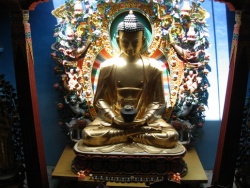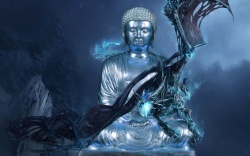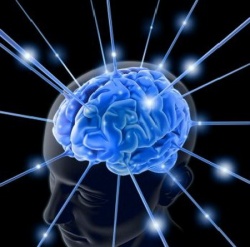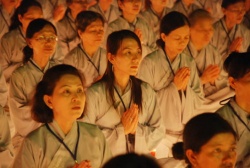Dharma protectors
dharma protectors (dharmapalas, hufashen): Beings who act to protect or guard the dharma and its adherents from all negative forces. If holy dharma protectors are properly evoked by one who practices the correct dharma, they can also bestow blessings and empowerment that will enable one to quickly become an enlightened holy being. They may be either holy “vajra beings” or unenlightened supernatural beings from the heavenly (devic), asura, ghost, or animal realms who are “oath bound” to protect the dharma and those who follow the dharma.
In a particular tradition that I am familiar with, it is said that there are three kinds of protectors. They are dharmapalas, lokapalas and ksetrapalas. Respectively they translate to "dharma-protectors," "world(ly)-protectors" and "field-protectors." Dharma-protectors are those who are highly advanced on the Path. From Vajrayana's point of view, these beings are actually manifestations of the activities of the Buddhas. Some of these beings are considered Buddhas while some are on different levels of the Bodhisattva path. For example, Mahakala and Ekazati are both considered fully enlightened beings while someone like Dorje Lekpa is considered a tenth stage bodhisattva. The worldly-protectors refer to beings who have pledged to protect the teachings and practitioners. These include powerful worldly gods, local spirits, energies and other beings. It is said that sometimes these beings do not even fully accept the teachings of the Buddha. They are in other words as deluded as we are - some of them more, others less. Field protectors are usually associated with very specific places or buildings. In Tibet, families live in the same place and house for hundred of years. As time passes, it is believed that there are certain protectors especially connected with that particular house, clan or family. Spiritually both the worldly and field protectors are much lower than the Dharma-protectors. Both the worldly and field protectors are not particularly related to Dharma in the same way as Dhama-protectors are.
How should we relate to the protectors? I remember reading His Holiness the Dalai Lama's response to a similiar question. His Holiness advised that it is actually sufficient to regard the Triple Gem (Buddha, Dharma and Sangha) as protectors. In his opinion, if one truly takes refuge in the Triple Gem they will be the best protectors one can have. He further explained that protectors are related to Vajrayana practice and only those who are deeply involved with Vajrayana practices should be concerned with the protectors. I suspect that His Holiness' response in this case is spoken for the general audience and in no way indicates that he is not in favor of protector practices. Other teachers also agree that if one really relies on the Triple Gem, protection is guaranteed.
Very briefly, according to Vajrayana, protectors should never be seen as something separate from oneself. Protectors actually have two levels which we can relate with. On the relative level, there are protectors like Mahakala, Palden Lhamo, Dorje Lekpa or Ekazati. There are numerous sadhanas (practices) associated with these protectors. But ultimately, it is our own rigpa (the natural mind which is empty, spacious and open) that is the protector. The sadhanas usually have a structure where the meditator visualizes him or herself as a particular protector. The meditator is reminded again and again that his or her own nature is never separate from the protectors'. Some teachers further explain that in a way, these protectors are simply our own awareness and mindfulness. Because we are beings with both body and mind, it is easier in the beginning for us to focus on some being with a form - the various protectors. By meditating on their enlightened form - the various attributes and ornaments (these are related to different enlightened qualities and activities), one is to actualize these same enlightened qualities in oneself. In a sense, we can say that the protectors are our own awareness and mindfulness appearing in enlightened forms. With right awareness and mindfulness, we will be able to relate to things as they truly are (the wisdom aspect) and carry out the bodhisattva activities (the compassionate aspect). Therefore, the effectiveness of these protectors are directly related to our own level of awareness and mindfulness. I have also heard another teacher explaining that the law of karma is the real protector. Here, he means that if one were to truly understand cause and effect, one will then abstain from performing any negative actions but instead only cultivate good.
Perhaps on a more advance level, the Dharma-protectors are related to different forms and levels of energies. These energies are said to be latent in us. By relating to a particular protector, one learns how to channel up a particular energy and to deal with it in an enlightened way. Because energy is simply energy (with negative and positive potentials), there is always a chance of not knowing how to deal with a certain energy that has been aroused through practice. Or perhaps the means of arousing that energy is misused. This is when it is believed that negative effects will occur.
This effect might not only affect the practitioner himself but might include other as well. Therefore, some teachers are extremely cautious when it comes to protector practices. In traditional language, protector's practice is something that one does only if one is certain that one can fulfill all the commitments (samaya or damtshig) related to that practice. Unlike practices like Chenrezig meditation or Tara, it is said that when the protector practice is done wrongly or is not done consistently, the protectors will get extremely "wrathful." These protectors are guardians of the different practices. It is also said that protectors are there to make sure that the purity of the lineage is protected. And to do that, they guard the practices of the practitioners.
It is not uncommon to hear people saying that when they became lazy in their practice or got distracted, something mysterious or supernatural happened that pulled them back into the Path again! And devout Tibetans will straightaway acknowledge the protectors for fulfilling their duties. There are also stories of protectors who guard termas - hidden "treasures" (teachings, ritual objects etc, that have supposedly been hidden by masters like Padmasambhava to be retrived in latter days to benefit people). Some of these protectors are even believed to fiecely guard these termas so that if the wrong people get these termas, they might be destroyed or the termas will simply vanish. These protectors are usually not Dharma-protectors but some worldly protectors.
Therefore, on the relative level, these protectors are treated like independent beings who have pledged to protect the Dharma (but since the ultimate and relative can never be taken as distinct, one is always reminded of the ultimate protector - one's own natural mind). Different lineages, teachers and practices have different special protectors. For example, Palden Lhamo and Dharmaraja is particularly associated with the Gelugpas. For the Kagyupas, Mahakala is especially significant. Different aspects of Mahakala (two-armed, four-armed, six-armed, female aspects) are practised by the Sakyas, Gelugs, Kagyus and Nyingmas.
In the Drikung-Kagyu (one of the major sects in the Kagyu school), Achi Chokyi Drolma is a protector intimately related to members of this lineage. Milarepa himself is related to the five protector goddesses of Tibet - known as the Tseringmas. Among the Nyingmapas, Ekazati, Rahula and Dorje Lekpa are protectors very closely related to Dzog-chen. The famous deity of the Nechung oracle is the personal protector of the Dalai Lamas. Various elaborate rituals and sadhanas are performed to these protectors in the lives of practitioners. There are certain monasteries that have protector practices carried out 24 hours a day for 365 days a year. If I am not mistaken, there are a group of monks specially charged with the task of performing protector practices for the welfare of His Holiness the Dalai Lama in particular, and the live of the Dharma in general.
The following is an attempt to try to explain the significance of "protectors" in the context of Vajrayana Buddhism. I have to confess with all honesty that my knowledge in this particular subject is extremely limited. Books that I have read regarding "protectors" are usually very vague, brief and even confusing at times. On top of that, I have not personally recieved any extensive teachings from the lineage teachers regarding this matter. And very often, these traditional teachers do not venture into any sophisticated psychological discourse on the significance of these "protectors" - with a few exceptions maybe.
It is important to bear in mind that consistency is not something that is given 100% attention to in Vajrayana. By this I mean that depending on different texts, sources, lineages and teachers, you will get slightly different classifications of things. For example, generally it is said that there are five Buddha-families but occasionally you will get references to a sixth family with Vajrasattva as the lord (in the five family classification, Vajrasattva belongs to the Vajra family with Aksobhya as the lord). Apparently, this six family scheme is rather popular among the Vajrayana lineages in Nepal. Anyway, back to the original point. Therefore, what I write here might not totally agree with what some others might have heard or read. But basically, I think the idea should be the same - that is assuming I am on the right track.
In a particular tradition that I am familiar with, it is said that there are three kinds of protectors. They are dharmapalas, lokapalas and ksetrapalas. Respectively they translate to "dharma-protectors," "world(ly)-protectors" and "field-protectors." Dharma-protectors are those who are highly advanced on the Path. From Vajrayana's point of view, these beings are actually manifestations of the activities of the Buddhas. Some of these beings are considered Buddhas while some are on different levels of the Bodhisattva path. For example, Mahakala and Ekazati are both considered fully enlightened beings while someone like Dorje Lekpa is considered a tenth stage bodhisattva. The worldly-protectors refer to beings who have pledged to protect the teachings and practitioners.
These include powerful worldly gods, local spirits, energies and other beings. It is said that sometimes these beings do not even fully accept the teachings of the Buddha. They are in other words as deluded as we are - some of them more, others less. Field protectors are usually associated with very specific places or buildings. In Tibet, families live in the same place and house for hundred of years. As time passes, it is believed that there are certain protectors especially connected with that particular house, clan or family. Spiritually both the worldly and field protectors are much lower than the Dharma-protectors. Both the worldly and field protectors are not particularly related to Dharma in the same way as Dhama-protectors are.
How should we relate to the protectors? I remember reading His Holiness the Dalai Lama's response to a similiar question. His Holiness advised that it is actually sufficient to regard the Triple Gem (Buddha, Dharma and Sangha) as protectors. In his opinion, if one truly takes refuge in the Triple Gem they will be the best protectors one can have. He further explained that protectors are related to Vajrayana practice and only those who are deeply involved with Vajrayana practices should be concerned with the protectors. I suspect that His Holiness' response in this case is spoken for the general audience and in no way indicates that he is not in favor of protector practices. Other teachers also agree that if one really relies on the Triple Gem, protection is guaranteed.
Very briefly, according to Vajrayana, protectors should never be seen as something separate from oneself. Protectors actually have two levels which we can relate with. On the relative level, there are protectors like Mahakala, Palden Lhamo, Dorje Lekpa or Ekazati. There are numerous sadhanas (practices) associated with these protectors. But ultimately, it is our own rigpa (the natural mind which is empty, spacious and open) that is the protector. The sadhanas usually have a structure where the meditator visualizes him or herself as a particular protector. The meditator is reminded again and again that his or her own nature is never separate from the protectors'. Some teachers further explain that in a way, these protectors are simply our own awareness and mindfulness.
Because we are beings with both body and mind, it is easier in the beginning for us to focus on some being with a form - the various protectors. By meditating on their enlightened form - the various attributes and ornaments (these are related to different enlightened qualities and activities), one is to actualize these same enlightened qualities in oneself. In a sense, we can say that the protectors are our own awareness and mindfulness appearing in enlightened forms. With right awareness and mindfulness, we will be able to relate to things as they truly are (the wisdom aspect) and carry out the bodhisattva activities (the compassionate aspect). Therefore, the effectiveness of these protectors are directly related to our own level of awareness and mindfulness. I have also heard another teacher explaining that the law of karma is the real protector. Here, he means that if one were to truly understand cause and effect, one will then abstain from performing any negative actions but instead only cultivate good.
Perhaps on a more advance level, the Dharma-protectors are related to different forms and levels of energies. These energies are said to be latent in us. By relating to a particular protector, one learns how to channel up a particular energy and to deal with it in an enlightened way. Because energy is simply energy (with negative and positive potentials), there is always a chance of not knowing how to deal with a certain energy that has been aroused through practice. Or perhaps the means of arousing that energy is misused. This is when it is believed that negative effects will occur.
This effect might not only affect the practitioner himself but might include other as well. Therefore, some teachers are extremely cautious when it comes to protector practices. In traditional language, protector's practice is something that one does only if one is certain that one can fulfill all the commitments (samaya or damtshig) related to that practice. Unlike practices like Chenrezig meditation or Tara, it is said that when the protector practice is done wrongly or is not done consistently, the protectors will get extremely "wrathful." These protectors are guardians of the different practices.
It is also said that protectors are there to make sure that the purity of the lineage is protected. And to do that, they guard the practices of the practitioners. It is not uncommon to hear people saying that when they became lazy in their practice or got distracted, something mysterious or supernatural happened that pulled them back into the Path again! And devout Tibetans will straightaway acknowledge the protectors for fulfilling their duties. There are also stories of protectors who guard termas - hidden "treasures" (teachings, ritual objects etc, that have supposedly been hidden by masters like Padmasambhava to be retrived in latter days to benefit people). Some of these protectors are even believed to fiecely guard these termas so that if the wrong people get these termas, they might be destroyed or the termas will simply vanish. These protectors are usually not Dharma-protectors but some worldly protectors.
Therefore, on the relative level, these protectors are treated like independent beings who have pledged to protect the Dharma (but since the ultimate and relative can never be taken as distinct, one is always reminded of the ultimate protector - one's own natural mind). Different lineages, teachers and practices have different special protectors. For example, Palden Lhamo and Dharmaraja is particularly associated with the Gelugpas. For the Kagyupas, Mahakala is especially significant. Different aspects of Mahakala (two-armed, four-armed, six-armed, female aspects) are practised by the Sakyas, Gelugs, Kagyus and Nyingmas.
In the Drikung-Kagyu (one of the major sects in the Kagyu school), Achi Chokyi Drolma is a protector intimately related to members of this lineage. Milarepa himself is related to the five protector goddesses of Tibet - known as the Tseringmas. Among the Nyingmapas, Ekazati, Rahula and Dorje Lekpa are protectors very closely related to Dzog-chen. The famous deity of the Nechung oracle is the personal protector of the Dalai Lamas. Various elaborate rituals and sadhanas are performed to these protectors in the lives of practitioners. There are certain monasteries that have protector practices carried out 24 hours a day for 365 days a year. If I am not mistaken, there are a group of monks specially charged with the task of performing protector practices for the welfare of His Holiness the Dalai Lama in particular, and the live of the Dharma in general.
So... if I have not totally confused my readers, I hope some of you will at least get a faint idea of what protectors are. If there is anyone out there that have further knowledge and experience that can be shared, do contribute! Call me a conservative, but part of the problem with trying to explain protector practice is that I am not sure what I should write and what I shouldn't. IMHO, protectors can be easily misunderstood. They can be easily seen as spiritual policeman that are out there to get you if you misbehave. And lots of supersitions can come up from this kind of understanding - this is the last thing that I am trying to do. If I have to summarize the significance of protectors very briefly, in say one or two sentences, the following will be it:
"Protectors, like other Buddhas and dieties related to one's practice, should NEVER be seen as separate from one's natural mind, one's rigpa. And to be mindful at all times of cause and effect is perhaps the most direct protector one can get."
Sarvam mangalam,
Hun Lye
See also; “Ten Dharma Protectors,” “Eight Guardians of the Law,” “Tantra and “eight types of celestial beings.”
See also; Dharmapalas







